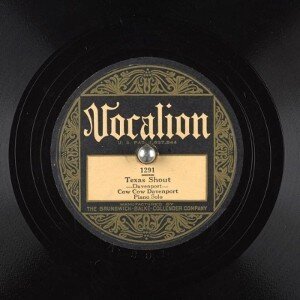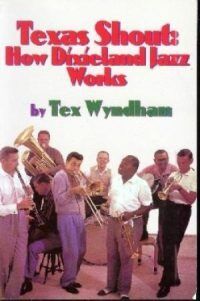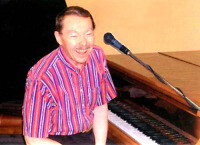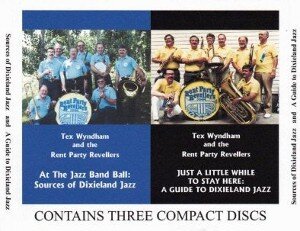 Set forth below is the thirty-eighth “Texas Shout” column. It first appeared in the April 1993 issue of the West Coast Rag now The Syncopated Times)
Set forth below is the thirty-eighth “Texas Shout” column. It first appeared in the April 1993 issue of the West Coast Rag now The Syncopated Times)
I recently read a record review in a respected jazz periodical in which the reviewer, discussing a singer whom I will refer to as “X,” said: “X … was not a jazz singer, X was not a dynamic improviser. … X was a practitioner of crooning …”
By contrast, in Jazz Singing, the only book-length treatment to date of the subject, author Will Friedwald states: “Louis Armstrong and X [are] the two most important figures in jazz-derived popular singing. … X’s greatest accomplishment … was the application of jazz to the music of Tin Pan Alley.”
These diametrically opposed assessments are characteristic of the confusion that exists among the jazz community whenever the question of jazz singing is discussed. This confusion, in my opinion, results because some jazz commentators are not comfortable viewing a singer as a musician whose instrument happens to be his/her own voice instead of a trumpet, trombone, piano, etc.
However, if you look at singers that way, you’ll have no trouble discerning which ones have the ability to sing jazz. You’ll do so simply by applying the same rules you’d use to determine whether any other instrumentalist has that talent.
First, let’s dismiss some red herrings. We’ll start with the “crooning” point raised above. The reviewer seemed to feel that X’s skills as a crooner could be offered as evidence that X could not sing jazz.
Well, Tommy Dorsey could produce one of the creamiest, most sensual tones ever heard from a trombone. He used that skill to great advantage on many successful non-jazz pop recordings. However, I’ve never heard anyone suggest that doing so somehow diminished his considerable talent as a jazz trombonist.
Benny Goodman not only deployed his singing clarinet on many romantic non-jazz dance sides, but also was, I understand, a creditable classical clarinetist. Anyone who used those facts to try to prove that Goodman was not also a jazzman would be laughed out of the room.
A singer may be able to croon, yodel or hum, and may attain an enviable reputation in the pop market by doing so. However, that statement tells you absolutely nothing about whether that singer also has the ability, when called for, to sing jazz. Just because you can do one thing well doesn’t mean you can’t also do something else well in the bargain.
Probably because the late Nat “King” Cole emerged from the jazz community in the first place, and was in fact one of the best jazz pianists of his day, he has always been universally acknowledged, and rightly so, to be a great jazz singer as well. However, Cole was also a “crooner” if there ever was one, achieving his greatest fame and success via his distinctive, smooth, intimate vocalizing on ordinary pop ballads.
For a second red herring, the above-quoted reviewer also seemed to feel that one could not be a jazz singer unless one was a “dynamic improvisor.” This conclusion reflects the commonly-held notion that improvisation is a sine qua non of jazz.
I have addressed this notion several times in previous “Texas Shout” columns. I don’t want to go through the reasoning again in detail today, but if you’ve been a steady reader, you will be familiar with my view that improvisation, though typically a predominant part of most jazz performances, is not essential to jazz. There are many well-known hot dance sides from the twenties, swing-band 78s from the thirties, progressive and bop rides from the forties, etc., which are fully scored from beginning to end and which are recognized by all and sundry to be jazz renditions.
The distinguishing feature of jazz, as I have often stated in these pages, is its unique rhythmic feeling, the characteristic that most jazzmen refer to as “hot, swinging” rhythm. An instrumentalist who can play music with that feeling has the ability to play jazz, without regard to whether the notes are improvised or scored, or to whether they are played with a tart tone or a velvety “croony” timbre.
In short, if an artist can be hot and swinging when required, then he/she can play jazz. That’s the rule you apply to trumpeters, trombonists, pianists, etc., and it’s the same rule you apply to vocalists.
By that rule, we recognize that Ella Fitzgerald, who often improvises wildly adventurous melodic lines, is a jazz singer, but so is the wonderful Maxine Sullivan, who swung effortlessly and naturally while rarely deviating much from the melody lines written by the composers.
By that same rule, we can see that many successful singers, some of whom had excellent voices, did not possess the ability to sing jazz. Al Jolson, one of the most dynamic and popular entertainers of all time, who had a rich voice and impeccable timing and pitch, apparently could not swing, or at least if he could, he never did so on record. History, then, does not include Jolson in its list of jazz singers, nor Eddie Cantor, nor Sophie Tucker, nor Gene Austin (one of the twenties’ most popular singers, now mostly forgotten).
You’ll be able to use this rule to find out which of the singers you encounter belong on your list of jazz singers. For the benefit of those who might like to investigate this subject a bit more, I’d like to use the balance of this column to mention some vintage-period jazz vocalists whom I have particularly enjoyed over the years.
I do not intend to be exhaustive in naming individuals. The omission of your particular favorite – maybe Sinatra or Calloway – is in no way intended as a slight or a denigration of that person’s skill. If you want to add some names to the ones mentioned herein, I’d probably go along with most of them.
Number One for me, and probably for many others, is Bessie Smith. The majesty and power of that great big voice are simply galvanizing, triumphing not only over sometimes inferior material but also over her somewhat limited range, to the point that there are no bad Bessie Smith records. Fortunately, her recordings are almost constantly in print. If you have never heard any of them, you’re really missing something.
The only other Black female of the twenties who can be mentioned in the same breath with Bessie is, of course, Ma Rainey, whose rich voice adorns a wide variety of material from vaudeville songs to jug band ditties. I also have a soft spot for Clara Smith, whose heavy, dark tones were particularly effective on very slow, sombre tunes. Ma Rainey’s recordings will be at nearly any large record store with an extensive blues section, but Clara Smith’s sides, if available at all, will only be found from specialty dealers.
You’ll also have to dig to find recordings by the white jazz thrush who stood head and shoulders above her competition in the 1920s, the irresistible Annette Hanshaw. Discovered as a teenager singing at a party, she became a big star even though she didn’t care much for show business and got out of it after a relatively few years. Her clear-toned, unaffected singing, sometimes accompanied by her own piano or ukulele, sometimes by the best of New York’s white jazzmen, sounds as fresh and appealing today as when it was recorded decades ago.
Before we turn to the male singers, I’ll toss in the name of one little-known sleeper, the ill-starred vaudevillian Jane Green, who waxed about twenty sides in the mid-1920s. A dozen of them were collected in 1989 on Superbatone 732, if you can unearth a copy, I’ll bet you won’t be sorry.
Among the 1920s males, the list starts with Louis Armstrong, the person who virtually defined jazz singing (along with many other things in the jazz vocabulary). The next name is that of X in the example that opened this column, Bing Crosby.
Friedwald’s above-quoted assessment of Armstrong and Crosby ought to be beyond dispute. From Crosby’s earliest recordings with Bix, The Rhythm Boys and various Whiteman sidemen right through his swinging LP with Bob Scobey’s band, Der Bingle obviously could get hot when he had a mind to do so. If you ask me, anyone who really believes Crosby couldn’t sing jazz ought to turn in his critic’s badge.
I don’t listen as much to reissues from the thirties as those from the twenties. However, I’ll listen to Mildred Bailey any time. The warmth of her voice and the comfortable feeling of her delivery put her at the top of my thirties list, closely followed by Lee Wiley and Maxine Sullivan.
Ms. Wiley’s singing combines a fun-loving wholesomeness with a faint but definite seductiveness in a way that I’ve never heard equaled. Ms. Sullivan, as mentioned, stuck to business, blending her smooth pipes, crystal-clear enunciation and dead-center pitch into an understated style that, in its subtle fashion, swung like mad.
On the male side, Jack Teagarden first appeared in the twenties, as did Ms. Bailey, but both came into their own in the thirties. Tea’s relaxed drawl was the perfect complement to his facile blues-tinged trombone.
Fats Waller wasn’t your conventional singer, but the same forceful rhythm and joie de vivre of his piano playing shines through his vocals. While we’re on singing pianists, let’s mention Nat “King” Cole again.
And while we’re on unconventional singers, let’s move up to the Dixieland revival period and pick up the hoarse shouting approach of Turk Murphy, whose powerful vocals were, like Teagarden’s, cast in the same mold as his fruity sliphorning. Turk’s sometime colleague in the Yerba Buena Jazz Band was the marvelous Clancy Hayes, whose Crosbyish singing gave new life to many previously neglected tunes that are now staples of the West Coast revival Dixieland style.
Vocal by Clancy Hayes
I could go on, but those names will do for now and I have a couple of other stories to tell you. Before I do so, however, and even though I haven’t dealt with the contemporary scene, I want to mention one present-day singer who hasn’t appeared much, if at all, on the West Coast festival circuit and whose name might therefore be unfamiliar to many of you.
George Buck’s various labels include a number of releases featuring Barbara Lea. They display a poised singer with a lovely voice who has superb taste in selecting worthwhile but underrecorded material.
I told you that the persons mentioned herein do not comprise an exhaustive list of singers I admire. However, one admission is so glaring that I feel compelled to explain it.
When all-time great jazz figures are being cited, there are certain names that always turn up on everyone’s list. Some of them are not artists to whom I personally prefer to listen, but I have no trouble understanding why they are cited.
For example, though I don’t care for bop, I can understand it enough to appreciate the nature of the changes wrought by Dizzy Gillespie and Charlie Parker. Parker might just have been the second most influential jazzman of all time (behind Armstrong), while Gillespie was one of the most technically gifted trumpeters of his era. Both deserve the adulation they have received.
Similarly, I don’t listen much to Art Tatum because I think that he too often let his blinding keyboard dexterity take precedence over creative thinking. However, Tatum was probably the most technically accomplished pianist jazz has ever known. I consider his 3/21/33 “Tiger Rag” for Brunswick to be the single best recorded piano solo I’ve ever heard. Tatum clearly ranks with jazz’s immortals.
However, I have been unable to reach the same conclusion with respect to Billie Holiday. I am obviously missing something that everyone else can easily hear, but I find her voice not particularly pleasant and her articulation and pitch frequently erratic.
I have dutifully bought the recordings that most jazz commentators rank among her best, the small combo sides with Teddy Wilson, and listened carefully to them. The jazz is wonderful, but I don’t hear Lady Day adding much to the proceedings most of the time. I have rarely gotten these sessions back off the shelf.
Thus, though Ms. Holiday is considered by some respected critics to be the greatest female jazz singer who ever lived, she has been missing on purpose from my “favorites” list. Perhaps someday I will get her message, as I eventually did in the story I am about to relate.
There is just one singer who affects me with the same emotional impact as Bessie Smith. I was first exposed to her some 35-40 years ago, when I was just beginning to dig deeply into jazz.
As many of you know, I came to Dixieland via the West Coast revivalists. Initially, I was not finely attuned to the nuances of jazz singing, but I knew how highly Bessie Smith was regarded. I had bought some of her records and was beginning to assimilate them when I read of another singer who was favorably compared to her.
Back then, you could take LPs into a booth in the store and audition parts of a few tracks. So, following the lead, I listened to this second singer. However, she wasn’t singing with a jazz background. Not hearing my beloved banjo and tuba, nor much other jazz, and not fully knowing what to listen for, I bypassed the album. Shortly thereafter I saw this artist in a feature film and had the same experience.
As the decades went by, I became immersed in all aspects of Dixieland and eventually developed a taste for a music closely related thereto – pre-war (or “country” or “acoustic” blues), which includes certain types of religious music. I’ll elaborate on blues & gospel in another column, but for now, I’ll say that this interest brought me full-circle back to the artist I had bypassed many years ago.
When Columbia brought out a special boxed set of her material in 1991, I decided to take a chance on the audiocassette version. After about four tracks, I went back to buy the CD version as well for my permanent collection, all the while kicking myself for the many years during which I was missing out on this artist.
Now I rarely take an automobile trip without at least one of the cassettes from C2T 47083 “Gospels, Spirituals & Hymns” by Mahalia Jackson, and I am in the process of trying to acquire as many of her recordings as possible. Ms. Jackson may not be performing jazz songs, and she may not be singing with jazzmen behind her, but she can, and often does, outswing anyone you’d care to name.
Listen, for example, to the power and drive of “Roll, Jordan, Roll” in that collection. And if you can get all the way through “I Found The Answer” without being moved by the passion, joy and resonant beauty in that voice, you’re more hard-hearted than I.
I have occasionally talked to fans who tell me that they don’t like vocals. Having heard some of the “vocalists” who’ve made it onto records and festival stages, I can see how some listeners might be discouraged in that respect.
However, as I’ve said, the voice is an instrument. Deciding that you don’t want to hear it, no matter how well played, makes as much sense as deciding that you don’t want to hear a band with a trumpet, or a trombone, or piano, or some other instrument that, like the voice, can be handled badly or can be handled so well that you’ll be transformed by it.
The singers recommended herein are among those who have made me realize how enjoyable jazz singing can be. Perhaps if you sampled a cross-section thereof, you’d find additional riches in our music.
If you want to investigate the subject in depth, Friedwald’s book, mentioned above, is a good place to start. It’s written in a conversational fan-oriented style, talks about all the right people, gives you leads to names that will be new to you, and even includes a useful discography (unfortunately, mostly of LPs, difficult to locate today). Its only deficiency is that Friedwald does not tell you in so many words what he thinks jazz singing is, nor does he always tell you what you should be listening for with respect to the individual singer he’s discussing.
However, I’ve given you a definition of jazz singing in today’s column that should keep you on the right road. Let me know how you come out.

The full run of “Texas Shout” has been collected into a lavishly illustrated trade paperback entitled Texas Shout: How Dixieland Jazz Works. This book is available @ $20.00 plus $2.95 shipping from Tex Wyndham, On request, Tex will autograph the book and add a personalized note (be sure to tell him to whom the note should be addressed).
Tex Wyndham’s 3 CD Guide to Dixieland with music and commentary is available for $20 plus $2.95 shipping. The separate CD, A History of Ragtime: Tex Wyndham Live At Santa Rosa, is available for $13.00 plus $2.00 shipping. On request, Tex will autograph the inner sleeve and add a personalized note (be sure to tell him to whom the note should be addressed).
Send payment to Tex Wyndham, P.O. Box 831, Mendenhall, PA 19357, Phone (610) 388-6330.
Note: All links, pictures, videos or graphics accompanying the Shouts were added at the discretion of the Syncopated Times editorial staff. They did not accompany the original columns and do not necessarily reflect the opinion of Tex Wyndham.
From roughly 1970-2010, Tex Wyndham was: (1) one of the best-known revivalist Dixieland jazz musicians in the US, as cornetist, pianist and bandleader, (2) one of the best-known ragtime pianists in the US, and (3) one of the most respected critics in the US of Dixieland jazz, ragtime, and related music. He is the only person about whom all three of those statements can be made.




